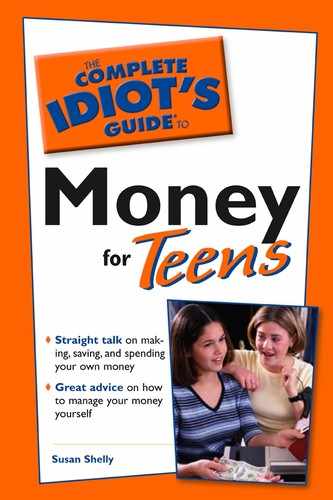Introduction
It’s increasingly recognized that teenagers and their money are forces to be reckoned with. You, as a collective group of teenagers, wield tremendous buying power, making you very attractive to all kinds of retailers and advertisers. Statistics from the U.S. Department of Labor show that the average teenager spends almost $5,000 a year. That’s more than double from just five years ago.
While you’re spending more money, you’re also becoming smarter about your finances. You’re not only stashing money away in savings accounts, you’re investing in CDs (certificates of deposit), mutual funds, and the stock market. You’re not only buying from other people’s businesses, you’re starting and running your own businesses.
Teenagers are innovative, creative, and not afraid of the future. However, to ensure a financially comfortable future, you need to know even more about the best ways to handle your money. Your personal finances are important to retailers and marketing firms, but they’re even more important to you.
This book walks you through the basic money matters and delves into weightier topics such as credit cards, investing and investment clubs, and being an entrepreneur. You’ll learn how to make the most of your money so you’ll have more to save, invest, and spend.
What You’ll Find in This Book
The Complete Idiot’s Guide to Money for Teens is written in six parts:
Part 1, “Money: A Fact of Life,” explains why money is so important in our society and the role it plays in most of our lives. You no doubt have discovered the power of money by now. You probably understand that money not only lets you buy what you need and want, it gives you choices and lets you do what you want to do.
This part also discusses the importance of keeping money in perspective. After all, it’s important, but it doesn’t by itself ensure happiness or contentment.
Part 2, “So, How Are You Gonna Get It?” deals with the big problem that most teens have: There just never seems to be enough money for all the stuff you want to buy and do. Everything is expensive these days, and it’s hard to make your allowance or paycheck stretch to cover everything you want or need.
You’ll learn how to negotiate for more allowance or to find a job that you can handle while still leaving time for the other parts of your life. You’ll also find that your net worth might be more than you think. It’s possible that you have some money lying around that you don’t even know about!
“Smart Saving” is the title of Part 3, and in it you learn to do just that. You’ll take a little test to find out whether you’re more of a saver or a spender. If you find it easier to spend than to save, don’t be discouraged. There are tons of other people with the same problem, and there are ways to curb spending so you can save more.
Regardless of how much you save, however, you should be getting the best deal you can. Interest rates vary dramatically, depending on where you stash your money. And you, of course, want to get the highest interest rate you can.
In Part 4, “Smart Spending,” you learn that you can stretch your dollars by buying smart. You also learn why you need a budget (everyone does), and what it should include. By keeping an eye on what and how you spend, you can get a lot more of the things you need without sending yourself to the poorhouse.
In Part 5, “Keeping Track of What You’ve Got,” the major topics are opening and keeping a checking account, using a debit card, and negotiating ATM machines. Using checks is great, and a smart idea in many cases. However, if you don’t take the time to record what you spend and to balance your checkbook, you’ll soon have a mess on your hands.
Debit cards and ATMs are extremely handy; but again, you need to know what you’re doing when using them. You need to be aware of all the fees associated with the use of these things, and understand how they affect your bank accounts.
In Part 6, “Advanced Money,” you learn about getting and using credit cards, investing your money, and starting your own business. This part is full of practical, useful information that’s sure to be interesting and beneficial.
Extras
In addition to the six parts found in this book, you’ll find three types of sidebars. These little bits of information are intended to keep you out of trouble, provide hot tips, and give you interesting tidbits that you might not have heard anyplace else.

Money Matters
These tips will keep you informed and in the know about your money and personal finances.

Imagine That
These statistics and offbeat bits of information are great to pass along to your friends. They’ll think you’re just so smart!

Scary Stuff
Hopefully, these warnings will keep you from making some common mistakes that could negatively affect your finances.
Acknowledgments
The author would like to thank the many people who provided time, interest, information, and resources for this book, especially the editors at Alpha Books: Randy Ladenheim-Gil, Tom Stevens, Billy Fields, and Rachel Lopez.
A great deal of thanks, as always, goes to Bert Holtje of James Peter Associates, with whom it is a pleasure and a privilege to be associated.
Much appreciation for valuable advice and their shared knowledge is extended to Sarah Young Fisher, George Shoffner, and John Sortino.
As always, the most special thanks goes to Mike, Sara, and Ryan McGovern.
Trademarks
All terms mentioned in this book that are known to be or are suspected of being trademarks or service marks have been appropriately capitalized. Alpha Books and Penguin Group (USA) Inc. cannot attest to the accuracy of this information. Use of a term in this book should not be regarded as affecting the validity of any trademark or service mark.
..................Content has been hidden....................
You can't read the all page of ebook, please click here login for view all page.
